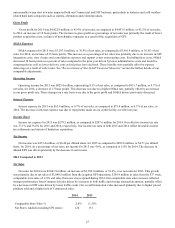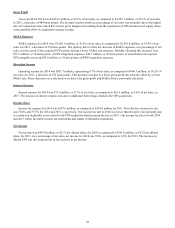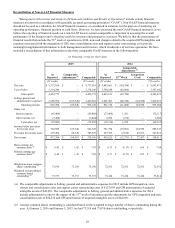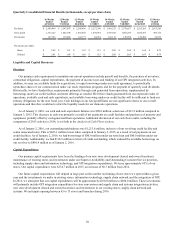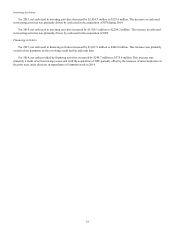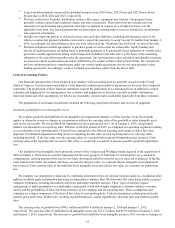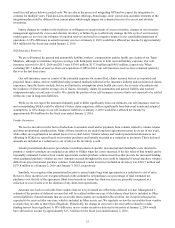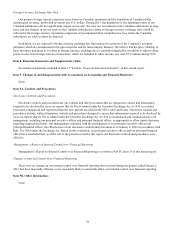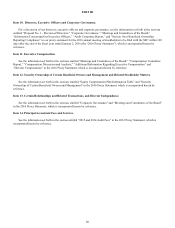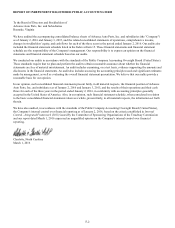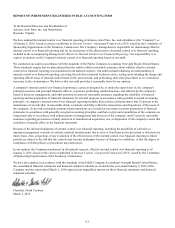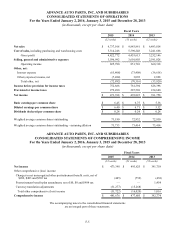Advance Auto Parts 2015 Annual Report Download - page 49
Download and view the complete annual report
Please find page 49 of the 2015 Advance Auto Parts annual report below. You can navigate through the pages in the report by either clicking on the pages listed below, or by using the keyword search tool below to find specific information within the annual report.36
foreign currency exchange rates. For the periods presented, the impairment assessments indicated that the fair values of each
reporting unit or asset group exceeded the carrying values of the respective goodwill or indefinite-lived intangible asset and
therefore no impairment existed. We have not made any material changes in the accounting methodology we use to assess
impairment loss during the past three fiscal years. We do not believe there is a reasonable likelihood there will be a material
change in the future estimates or assumptions we use to test for impairment losses on goodwill or indefinite-lived intangible
assets. However, if actual results are not consistent with our estimates or assumptions, we may be exposed to an impairment
charge that could be material.
Income Tax Reserves
The determination of our income tax liabilities is based upon the tax law, codes, regulations, pronouncements and court
cases for the taxing jurisdictions in which we do business. Our income tax returns are periodically examined by those
jurisdictions. These examinations include, among other things, auditing our filing positions, the timing of deductions and
allocation of income among the various jurisdictions. At any particular time, multiple years are subject to examination by
various taxing authorities.
In evaluating our income tax positions, we record a reserve when a tax benefit cannot be recognized and measured in
accordance with the authoritative guidance on uncertain tax positions. These tax reserves are adjusted in the period actual
developments give rise to such change. Those developments could be, but are not limited to: settlement of tax audits, expiration
of the statute of limitations, the evolution of tax law, codes, regulations and court cases, along with varying applications of tax
policy and administration within those jurisdictions.
Management is required to make assumptions and apply judgment to estimate exposures associated with our various filing
positions. Although Management believes that the judgments and estimates are reasonable, actual results could differ and we
may be exposed to gains or losses that could be material. To the extent that actual results differ from our estimates, the effective
tax rate in any particular period could be materially affected. Favorable tax developments would be recognized as a reduction in
our effective tax rate in the period of resolution. Unfavorable tax developments would require an increase in our effective tax
rate and a possible use of cash in the period of resolution. A 10% change in the tax reserves at January 2, 2016 would have
affected net income by approximately $2.8 million for the fiscal year ended January 2, 2016.
Inventory Reserves
Our inventory reserves consist of reserves for projected losses related to shrink and for potentially excess and obsolete
inventory. An increase to our inventory reserves is recorded as an increase to our cost of sales. Conversely, a decrease to our
inventory reserves is recorded as a decrease to our cost of sales. Our inventory reserves for 2015, 2014 and 2013 were $70.4
million, $49.4 million and $37.5 million, respectively. The increase in our inventory reserves in 2014 was primarily reflective
of the significant growth in our inventory due to the acquisition of GPI. The increase in our inventory reserves in 2015 was
primarily due to estimated shrink on a higher volume of product returns associated with our product changeovers and
conversions and increases to our excess and obsolete inventory reserve on imported product.
Shrink may occur due to theft, loss or inaccurate records for the receipt of merchandise, among other things. We establish
reserves for estimated store shrink at a point in time based on results of physical inventories conducted by independent third
parties in substantially all our stores and branches over the course of the year, results from other targeted inventory counts in
our stores and historical and current loss trends. In our distribution facilities, we perform cycle counts throughout the year to
measure actual shrink and to estimate reserve requirements. We believe we have sufficient current and historical knowledge to
record reasonable estimates for our shrink reserve and that any differences in our shrink rate in the future would not have a
material impact on our shrink reserve.
Our shrink rate has not fluctuated significantly over the last two years. Historically, we have not experienced material
adjustments to our shrink reserve. Furthermore, we have consistently completed a similar number of physical inventories at
comparable times throughout the year.
Our inventory consists primarily of parts, batteries, accessories and other products used on vehicles that have reasonably
long shelf lives. Although the risk of obsolescence is minimal, we also consider whether we may have excess inventory based
on our current approach for effectively managing slower moving inventory. We strive to optimize the life cycle of our inventory
to ensure our product availability reflects customer demand. We have return rights with many of our vendors and the majority
of excess inventory is returned to our vendors for full credit. We establish reserves for potentially excess and obsolete
inventories based on (i) current inventory levels, (ii) the historical analysis of product sales and (iii) current market conditions.
In certain situations, we establish reserves when less than full credit is expected from a vendor or when liquidating product will



